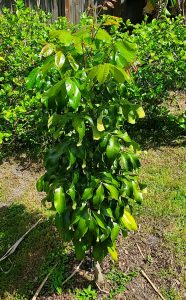
While many homeowners have the usual backyard fruits such as citrus, and maybe even some more exotic types such as mangos or lychees, one fruit tree not often seen is the longan. A relative to the lychee, the longan is becoming more popular in southern Florida. Producing fruit in August when few other local fresh tropical fruits are available, the longan may be something to add to your edible landscape.
Originating in Southeast Asia, the longan reached the U.S.A. in 1903 and has been a commercial crop in south Florida since the 1990’s. Commercial growers on nearby Pine Island in Lee County produce longans commercially. Well adapted to the subtropics where there is a period of cool, but not freezing winters, and dry periods in the fall and winter, longans are dependent on favorable weather and may not bear fruit every year. In a good year, a mature tree can produce over fifty pounds of fruit. The twelve-inch-long compound evergreen leaves are shiny and dark green in color – very ornamental. The flowers are small and arranged in clusters that are called panicles. The clusters of fruit that develop are round to oval and approach an inch in diameter. While growing to about thirty-five feet tall with an attractive rounded crown, longans should be trained to maintain a height of about fifteen feet tall for ease of harvesting the fruit. Once established, the longan is fairly drought tolerant, but not of wet or salty sites. While young trees are a bit cold sensitive, older trees can tolerate down to about twenty-six degrees F. Careful selection of a planting site within a warm microclimate in your yard or in proximity to water will better the chances of long-term productive growth in the face of any future winter freezes. A full sun location with well-drained soil is a preferred planting site. Space the trees about twenty-five feet away from other trees or buildings.
Consider fruit thinning – by reducing about fifty percent of the fruit set when they are about one-quarter of an inch in the spring, each remaining fruit will be significantly bigger and more appealing. This will help individual fruit reach the desired one and one-quarter of an inch (or bigger) diameter size which will have the most flesh and the best flavor. Fruits take up to one hundred and ninety days from flowering to reach mature fruit. Ready-to-eat in August, sample a few fruits to determine their maturity regarding sweetness and flavor. The brown, leathery covering is removed to expose the white juicy pulp which covers a fairly large brown seed. The pulp is sweet but has a different flavor when compared to a lychee. The fruit can be harvested as a cluster and should be moved to a cool location. Place the fruit in plastic bags and into a refrigerator where it will keep for about a week. You can freeze the fruit whole in plastic bags. The literature indicates that longans are a good source of potassium and are low in calories.
Check local nurseries and garden centers for longan varieties. Most longans in Florida are the cultivar ‘Kohala’. If you have a friend or neighbor with a longan, air layering is the most common type of propagation used on these fruit trees. With this method, you can get a new plant in about twelve weeks.
Consider adding a longan in your backyard fruit grove. The exotic taste and nature of this fruit, as well as its ornamental appearance, will make it a potential favorite. For more information on all types of tropical and subtropical fruits, or to ask a question, you can also call the Master Gardener Volunteer Helpdesk on Mondays, Wednesdays, and Fridays from 1 to 4 pm at 764-4340 for gardening help and insight into their role as an Extension volunteer. Ralph E. Mitchell is the Director/Horticulture Agent for UF/IFAS Extension Charlotte County. He can be reached at 941-764-4344 or ralph.mitchell@charlottecountyfl.gov. Connect with us on social media. Like us on Facebook @CharlotteCountyExtension and follow us on Instagram @ifascharco.
Resource: Crane, J. H., Balerdi, C. F., Sargent, S. A. & Maguire, I. (2019) Longan Growing in the Florida Home Landscape. The University of Florida Extension Service, IFAS.
 0
0
